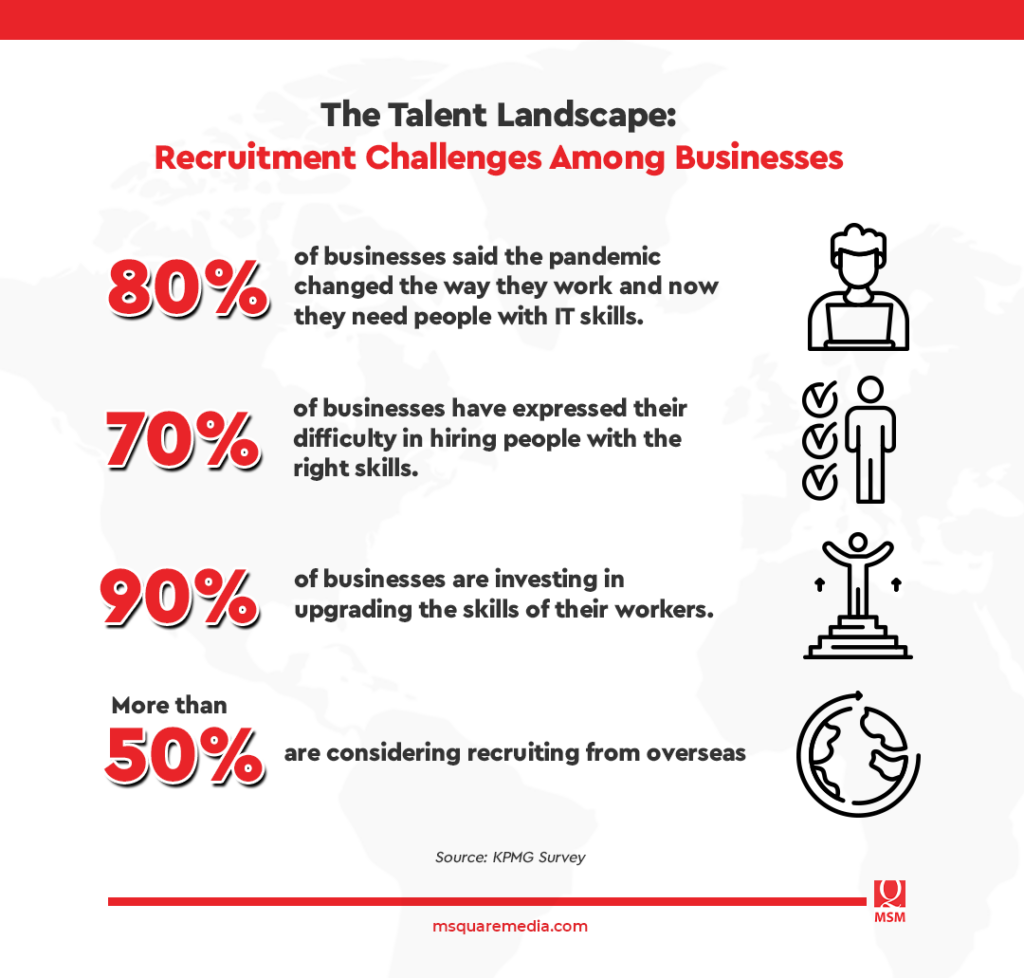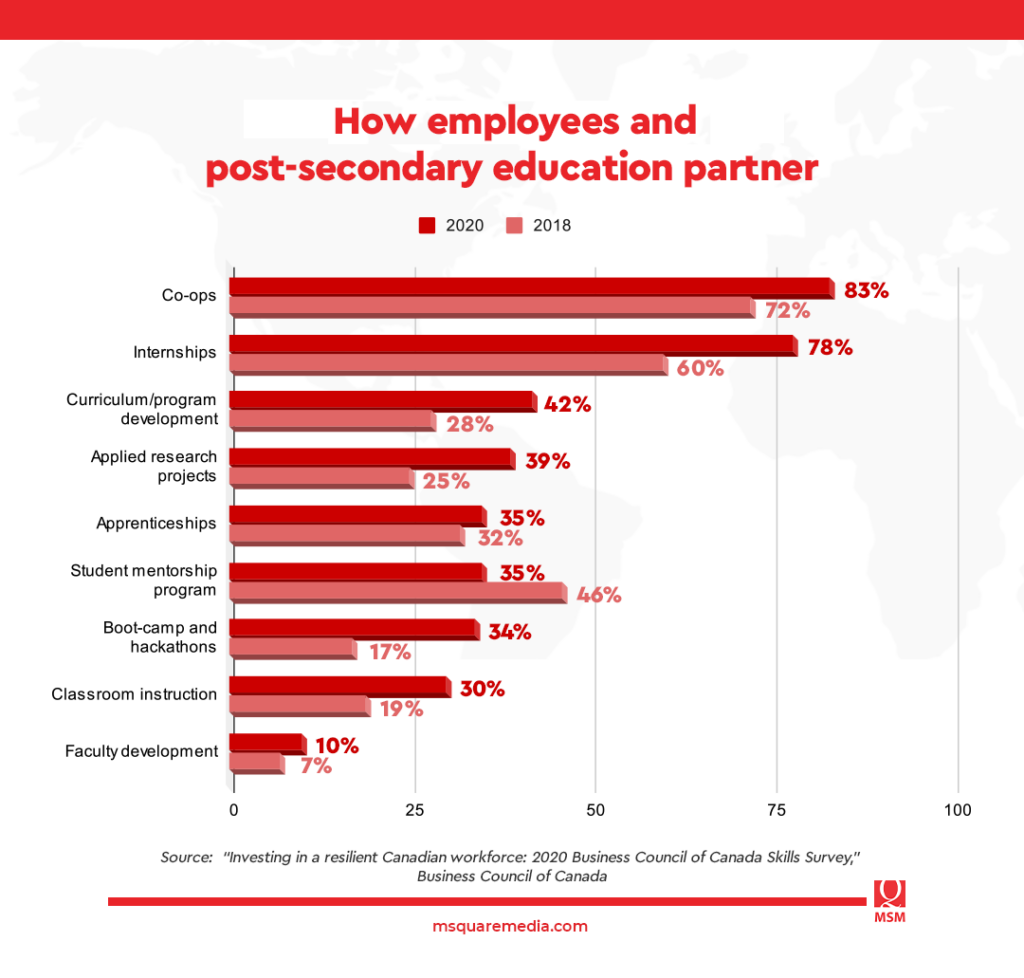For the better part of the last decade, the skills gap debate surrounding Canada made its way as a dominating theme in national news and government policies.
Key Points at a Glance
- A labor shortage and skills gap are not the same. Canada is facing a crisis of the latter.
- The Conference Board of Canada projects that the nation’s largest province, Ontario, will be short of half a million skilled workers by 2030.
- The Business Council of Canada identified upcoming skills shortages with four of five tech-related.
- Higher education institutions (HEI) play an important role in addressing the skills gap; 86% of businesses have a relationship with at least one HEI.
Definition
Primarily, one should be reminded of the difference between a labor shortage and a skills gap crisis. The two vastly differ from each other but are sometimes treated as one and the same. The former accounts for when there are not enough workers for job demands. The latter accounts for when, while there may be a lack or surplus of available workers, they might not have the skills needed by the employer. Another scenario of a skills gap may also include the hiring of an overqualified worker.
Former Minister of Employment and Social Development Canada, now Premier of Alberta, Jason Kenney, once stated that the skills gap is one of the biggest economic challenges facing the country.
The Conference Board of Canada stated that it had studied the projections of the skills gap since 2000, and that it expected the country to “fall short by a million skilled professionals by 2020.” It added that Ontario, Canada’s largest province, would fall short of about half a million skilled workers by 2030.
Identification of Skill Shortages
The Business Council of Canada, published results of a 2020 survey, which identified the top five coming skills shortages in Canada. The results were Analytics, Statistics and Quantitative Analysis; Cognitive Computing (Artificial Intelligence and Machine Learning); Computer Science; Skilled Trades (Construction, Electrical, Welding etc.); and Cybersecurity (Threat Analysis, File Recovery and Risk Management).
Notable is the fact that four out of five of these identified skills shortages are IT-related.
The skills gap is a cause for national concern. As the Business Council of Canada puts it: “There is a war for talent. We are all stealing from each other, which only perpetuates the problem. Because of the skills shortage, companies are losing key players, wages increase, and competitiveness is challenged.”
Results of a KPMG survey released August 2021 also showed that the ability to find and retain talent in the workplace is the top threat to growing businesses in the country.
Here are some numbers from the poll:

Partnerships
In line with these concerns, the post-secondary education institutions of Canada play a very important role in addressing the skills gap crisis. In the same survey by the Business Council of Canada, it found that 86% of businesses have a relationship with one or more educational institutions. They believe this will help them not only improve their talent but also gain insight into the future needs of their places of work.

“The new world of work is about skills, not necessarily degrees,” said JPMorgan Chase & Co. Chairman and Chief Executive Officer Jamie Dimon in 2019, after his company announced its $350 million New Skills at Work investment. This program aims to support community colleges and non-traditional career pathway programs.
Solutions
It would be premature to propose a one-size fits all approach in solving the skills gap issue in Canada, as it has become a national concern which spans two generations. However, one could look into some of these possible steps in addressing the widening skills gap, especially in a post-COVID economy.
- Digital Upskilling. As defined at the start of this article, a skills gap is not exactly the result of a labor shortage. The country has a good number of laborers. However, most of them are left on their own in the midst of a digital revolution, most especially spurred on by the pandemic. Companies may choose to invest in their workforce by letting them undergo training sessions in connection with learning digital skills. At the very least, this will make the transition from one generational workforce to another a more seamless process.
- Inclusive Recruitment. The fact remains that there are a lot on the lookout for job opportunities. The question, however, is how many of our companies are open to hiring, building and maintaining a workforce that is made up of a very diverse demographic. For one, there is a need to hire more women across all business sectors. Businesses need to listen to their needs as they have been among the ones whose careers have taken a hit during the pandemic. This is also a call for improved institutional partnerships and pathways.
- Creative Marketing. Everyone, from educational institutions to business establishments alike, needs to tell a more intriguing story on why the future needs men and women with future-proof skill sets. From a trade perspective, a refreshing reinvention of how one’s trade is seen by the public could be another way to invite young blood into the trade. A truck driver, for instance, is not just responsible for bringing goods from Point A to Point B. One could argue that the nation’s truck drivers allow for local commerce to thrive and that they are soldiers on the ground. Great stories are inspirational tools.
Opportunities
Based on what was previously discussed in this article, it can be presented that bringing in more international students with specific skills can be another welcome solution to the skills gap crisis in Canada.
International students are relatively young, which may therefore grant them more access and exposure to learning digital skills.
In terms of the country’s immigration policies, it has proved that it is strongly considering more and more international students. In 2020, Canada had moved to third place only after the United States and Australia when it comes to the international student population. The Immigration, Refugees and Citizenship Canada (IRCC) also released data which highlights Canada’s international student population increasing by 13% in 2019 compared to 2018. Not counting COVID and post-COVID numbers, which were impacted due to the health and travel restrictions all over the world, Canada’s international student population has been growing at an immense pace, growing sixfold since 2000.
Conclusion
Canada has a skill shortage, with more or less six out of 10 employees lacking training in new technologies. This causes a lack of productivity and high turnover rates, costing the country about $70 billion in GDP. On the other hand, international students contribute about $22 billion to the country’s economy annually and help sustain over 170,000 jobs.
When it comes to the skills gap crisis, local and national businesses should not dismiss the economical short- and long-term gains of partnering or working closely with higher education institutions and supporting pathway programs in the country. (DONNA HOOKER)

Donna Hooker
President, MSM Higher Ed
Donna has worked in the international education field for more than 30 years. She has a comprehensive knowledge of policy and practice in the public post-secondary education system in British Columbia, Canada and worldwide. She is a past board chair for the BC Centre for International Education and has held senior management roles at BC Institute for Technology, Vancouver Community College, and most recently at Capilano University.
Donna has demonstrated excellence in leadership with a focus on international education and services marketing, as well as in her role as interim Dean of Business for three years at Vancouver Community College. Donna holds an MBA with a strategic focus on Services Marketing and International Education and has facilitated the professional development of others by teaching general business and service marketing in Canada as well as internationally. Donna joined M Square Media as President after having had an excellent firsthand experience as an MSM client.
Data sources:
Borwein, S. (2014). The Great Skills Divide: A Review of the Literature. Toronto: Higher Education Quality Council of Ontario. Retrieved from https://heqco.ca/wp-content/uploads/2020/03/Skills-Part-1.pdf
Jason Kenney delivers a keynote speech at the 2013 Electricity Human Resources Canada Conference (2013, November 7) Government of Canada. Retrieved from https://www.canada.ca/en/news/archive/2013/11/jason-kenney-delivers-keynote-speech-2013-electricity-human-resources-canada-conference.html
Three Steps to Solving the Skills Gap Puzzle (2021, April 14) Black and McDonald. Retrieved from https://blackandmcdonald.com/three-steps-to-solving-the-skills-gap-puzzle/
Investing in a resilient Canadian workforce: 2020 Business Council of Canada Skills Survey (2020) Business Council of Canada. Retrieved from https://thebusinesscouncil.ca/app/uploads/2020/08/2020-BCC-Skills-Survey-Report_Final.pdf
Digital skills shortage, lack of skilled labour No. 1 issue for Canadian businesses: Poll (2021, August 31) City News. Retrieved from https://toronto.citynews.ca/2021/08/31/digital-skills-shortage-lack-of-skilled-labour-no-1-issue-for-canadian-businesses-poll/
JPMorgan Chase Makes $350 Million Global Investment in the Future of Work (2019, March 18) JP Morgan Chase. Retrieved from https://www.jpmorganchase.com/news-stories/jpmorgan-chase-global-investment-in-the-future-of-work
Hodnett, S. (2021, February 20) How to solve the skills gap in Canada. Toronto Star. Retrieved from https://www.thestar.com/business/opinion/2021/02/20/how-to-solve-the-skills-gap-in-canada.html
Grekou, D. (2021, May 26) Gender differences in employment one year into the COVID-19 pandemic: An analysis by industrial sector and firm size. Statistics Canada. Retrieved from https://www150.statcan.gc.ca/n1/pub/36-28-0001/2021005/article/00005-eng.htm
El-Assal, K. (2020, February 20) 642,000 international students: Canada now ranks 3rd globally in foreign student attraction. CIC News. Retrieved from https://www.cicnews.com/2020/02/642000-international-students-canada-now-ranks-3rd-globally-in-foreign-student-attraction-0213763.html#gs.okj7hp
Chavez, J. (2021, March 22) Addressing Canada’s Skills Gap. University of Alberta. Retrieved from https://www.ualberta.ca/youalberta/2021/03/addressing-canadas-skills-gap-u-of-a-s-skillsx-advances-to-the-top-10-of-the-canada-comeback.html
International students contribute $22 billion annually to Canada’s economy. Path Advisors. Retrieved from https://www.pathadvisors.ca/international-students-contribute-22-billion-annually-to-canadas-economy/

